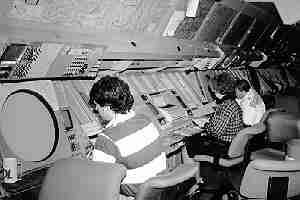 Ever made dinner reservations for 7:00 p.m., arrived at the restaurantat 6:56 and, upon giving your name to the maitre d’, discoveredthat not only is your table unavailable, but you can’t even getnear the dining room? Failing to grease the upturned palm witha ten, you find yourself in the lounge—waiting. In restaurantterms, you’ve been slapped with a hold.
Ever made dinner reservations for 7:00 p.m., arrived at the restaurantat 6:56 and, upon giving your name to the maitre d’, discoveredthat not only is your table unavailable, but you can’t even getnear the dining room? Failing to grease the upturned palm witha ten, you find yourself in the lounge—waiting. In restaurantterms, you’ve been slapped with a hold.
It’s the same with Air Traffic Control. You see, prior to becomingcontrollers, most of us worked our way through the FAA’s Academyin Oklahoma City waiting tables in the school’s cafeteria. There,we were taught not only to keep a dozen pilot requests straight,but we learned the importance of fielding complaints.
 ATC, unlike therestaurant business, serves its patrons on a first-come, first-servedbasis—unless you’re competing with Air Force One or Michael Jackson’sG-IV. Deprived of the chance to slip a ten to the controller ("Psst,let’s say we skip the hold and go direct, eh?") you’re forcedto wait your turn. In a busy environment, someone will be first,and everyone else will follow. When the conga line gets too long,someone has to wait in the lounge.
ATC, unlike therestaurant business, serves its patrons on a first-come, first-servedbasis—unless you’re competing with Air Force One or Michael Jackson’sG-IV. Deprived of the chance to slip a ten to the controller ("Psst,let’s say we skip the hold and go direct, eh?") you’re forcedto wait your turn. In a busy environment, someone will be first,and everyone else will follow. When the conga line gets too long,someone has to wait in the lounge.
Half our purpose in ATC is to get airplanes from the sky and ontothe ground (preferably at their destination airports) as safelyand quickly as possible. Holding interrupts the flow, but it’ssometimes, the only alternative.
The reasons for holding are as varied as the number of controllersin the system. Holding is not the norm where I work. I can’t speakfor busier facilities, but if I initiate holding my troubles arejust beginning.
Holds definitely have a regional flavor. A coastal airport, forinstance, might be routinely fog-bound until mid-morning, clearall afternoon and W0X0F again at sunset. To avoid holds, localpilots schedule themselves accordingly.
The midwest has a less predictable day. A cool morning with gentlesoutherly breezes can lead to a wicked afternoon with toweringcumulus building into thunderstorms. Winds shift with each passage.The runways disappear under heavy rain showers, and pilots mayfind themselves unable to even approach the field.
For controllers, the problem of where to put airplanes is compoundedby the weather. As thunderstorms grow, airspace vanishes. A handfulof airplanes are squeezed into tighter places while voices onboth ends of the frequency grow strained.
"Cleared to the (fix); hold as published…"should be the easiest solution. But what if the published holdsits in the middle of Level 5 cell? A new holding pattern mustbe created. All bets are off; it’s the controller’s chance tobe creative. A clearance direct to the VOR might be easiest, or,my favorite, a DME fix on the inbound radial you happen to beon. I’ve even asked pilots to hold over ground reference points,such as lakes.
Just because you’re on an IFR flight plan, doesn’t mean we can’tnegotiate a simpler way to park you. I’ve asked pilots to simplymake a couple of 360s to buy time. Of course, there’s no EFC butin the event of lost comm, I’d expect them to follow normal lostcomm procedures, via last route cleared, or expected, and so on.
A winter snowstorm can clog the system for hours. Once the visibilitylifts, the runways are usually packed with snow. Estimates ofrunway opening time are always optimistic. The result: Everyoneholds, maybe on the ground at the departure airport or, less desirably,airborne. In this scenario, the easiest way to hold is to stickeveryone on the localizer, at separate altitudes and, as runwayconditions allow, peel off the arrivals one at a time, steppingeveryone down in the process.
How a pilot enters or flies the hold is almost moot because everyoneis separated by altitude. In more complex airspace where holdingmight be in progress at a number of fixes, the pilot’s abilityto remain within protected airspace could become a more seriousconsideration. A target wandering away from the hold could drawa gentle "Where are you going?" followed by a hand-holdingvector back to the corral.
Can I tell if your hold entry is FAA/AIM/Martha King-approved? Teardrop, parallel or direct? Maybe. Do I care? No. As longas your radar target is mushing around the vicinity of the fixand at the altitude assigned, I don’t get too concerned.
If you actually find yourself compelled to hold and you haven’tthe foggiest notion how to enter the pattern, don’t panic. There’sno air traffic snitch in the radar room measuring your turnsor timing your inbound legs. Just jump right in, hold altitudeand thrash your way through it the best you can. If you get boredwith right turns, ask for left. If you want longer legs, speakup.
Glean what you can from the ATIS regarding delays. If holdinglooms ahead, ask for a speed reduction. Maybe you’ll never getto the hold and even if you do, it can’t last forever. Remember,in more than 50 years of air traffic control, we haven’t leftone up there yet.
| Editor’s Note: For more, see "Hold Entries Revisited" by Paul Bertorelli. |


































